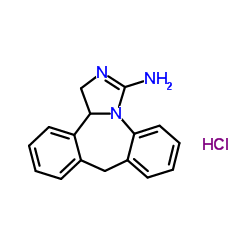Ocular comfort and drying effects of three topical antihistamine/mast cell stabilizers in adults with allergic conjunctivitis: a randomized, double-masked crossover study.
Gail L Torkildsen, George W Ousler, Paul Gomes
Index: Clin. Ther. 30(7) , 1264-71, (2008)
Full Text: HTML
Abstract
The aim of this study was to compare short-term (5-minute) ocular comfort and drying effects of 3 topical antihistamine/mast cell stabilizers-epinastine, azelastine, and ketotifen-in patients with allergic conjunctivitis (AC).Adults with a history of AC, as confirmed on skin testing conducted within the previous 2 years, were enrolled in this single-center, randomized, double-masked crossover study. At visit 1, patients were randomized to receive a single drop of epinastine in 1 eye and either azelastine or ketotifen in the other eye. Ocular comfort was assessed by patients on an 11-point scale (0 = very comfortable to 10 = very uncomfortable) immediately (0 minute) and at 0.5, 1, 2, and 5 minutes after instillation. Patients were also asked to describe how their eyes felt at 3 minutes using a standardized list of positive (soothing, smooth, refreshing, cool, and comfortable), neutral (thick, sticky, and filmy), and negative (stinging, irritating, and burning) descriptor words. At visits 2 to 4, patients were examined for ocular drying and tear-film stability using fluorescein staining and ocular protection index (OPI) evaluation, respectively.A total of 40 patients (27 women, 13 men; mean age, 40 years [range, 18-73 years]) were included in the study. The mean comfort score was significantly lower (indicating more comfort) with epinastine compared with azelastine at 0.5, 1, 2, and 5 minutes (between-treatment differences, 2.90, 1.85, 1.35, and 0.63, respectively; P < 0.001, P < 0.001, P = 0.001, and P = 0.019) and compared with ketotifen immediately after instillation (between-treatment difference, 1.2; P = 0.014). The mean ocular comfort score was significantly lower with ketotifen compared with azelastine at 0.5, 1, and 2 minutes (between-treatment differences, 2.35, 1.35, and 1.10, respectively; P = 0.001, P = 0.023, and P = 0.028). A majority (85%) of patients chose positive comfort descriptors to describe epinastine versus 34% with azelastine. No significant differences in fluorescein staining or OPI were observed.In this small study in patients with AC, following administration of a single drop, epinastine was rated as more comfortable than azelastine and ketotifen. None of the tested medications were associated with significant acute ocular drying effects.
Related Compounds
| Structure | Name/CAS No. | Molecular Formula | Articles |
|---|---|---|---|
 |
Epinastin HCl
CAS:108929-04-0 |
C16H16ClN3 |
|
Development and validation of an ultra-performance liquid ch...
2015-03-01 [Biomed. Chromatogr. 29(3) , 465-74, (2015)] |
|
Honey bee dopamine and octopamine receptors linked to intrac...
2011-01-01 [PLoS ONE 6(11) , e26809, (2011)] |
|
Differential effects of octopamine and tyramine on the centr...
2009-03-01 [J. Comp. Physiol. A. Neuroethol. Sens. Neural. Behav. Physiol. 195(3) , 265-77, (2009)] |
|
Treatment of allergic conjunctivitis: results of a 1-month, ...
2010-01-01 [Eur. J. Ophthalmol. 20(5) , 811-8, (2010)] |
|
Latent inhibition in an insect: the role of aminergic signal...
2012-01-01 [Learn. Mem. 19(12) , 593-7, (2012)] |